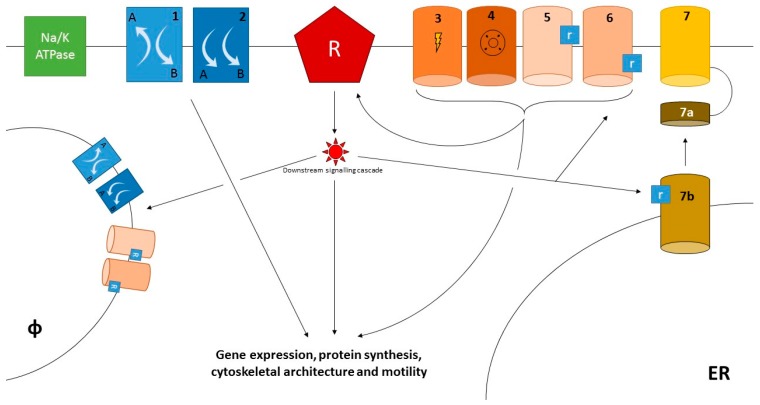Figure 1.
Ion channels and transporters. Ion channels and transporters may affect the behaviour of innate and adaptive immune cells at several levels. Under resting conditions, ion gradients between the intra- and extracellular space are actively generated through the Na/K ATPases. These gradients are exploited by transporters (1, 2) to trim the concentrations of other ions, including calcium. Cell activation after engagement of a cell-specific receptor (R), e.g., the BcR or TcR for lymphocytes or the FcR for myeloid cells, promotes the deployment of downstream signalling cascades that ultimately affect gene expression, protein synthesis and cause cytoskeletal remodelling, enabling cells to perform effector tasks such as chemotaxis, phagocytosis and release of antimicrobial moieties or cytokines. Activation of surface ion channels is integral to these events. A first set of ion channels are activated by physical or biochemical stimuli such as voltage (3), intracellular osmotic pressure (4) or engagement of extracellular (5) or intracellular (6) ligands, which in turn may be directly or indirectly induced by the activation of cell-specific receptors. Conversely, ion currents generated by voltage-operated or receptor-operated channels can exert feedback or feedforward effects on cell activating receptors. Specifically, raised calcium concentrations play a prominent role in mediating cell activation. However, to this regard store-operated calcium entry (SOCE, 7) generally provides a more significant contribution compared to voltage-operated or receptor-operated calcium entry (VOCE, ROCE). SOCE is propitiated by the activation of a inositol-1,4,5-triphosphate (IP3) receptor channel on the surface of the endoplasmic reticulum (ER, 7b). Increased intracellular IP3 concentrations are part of the changes induced by cell activation downstream cell-specific receptors (R). The release of calcium from ER stores is then sensed by adaptor proteins such as stromal interaction molecules (STIM; 7a), which in turn activate surface receptors (7), such as those of the ORAI family. Beside the cell surface, ion channels and transporters can also be expressed on intracellular compartments such as the phagolysosomes (φ). In this setting, they trim the endosomal pH, thus favouring the digestion of microbes and/or other dangerous moieties.

